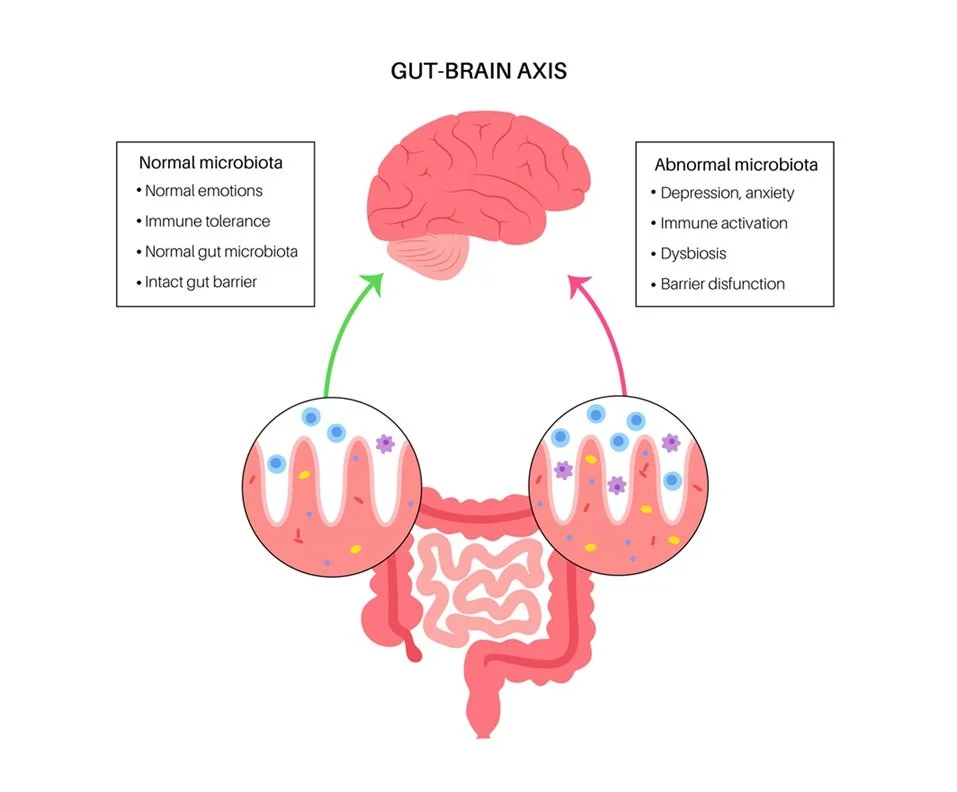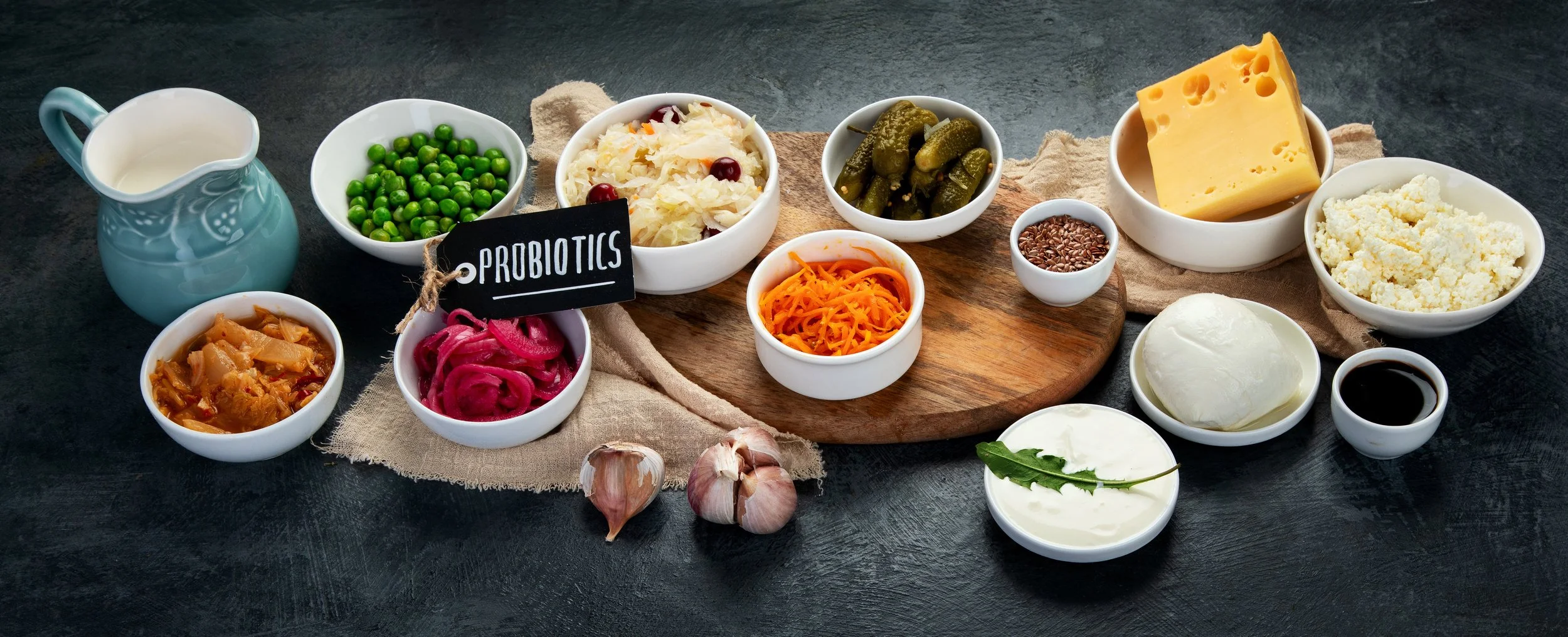Gut Instincts: Why Listening to Your Body Changes Everything
We’ve all felt it — the flutter of “butterflies” in the stomach before a big event, or that uneasy churn when stress hits hard. These sensations aren’t just in your head — they’re your gut and brain talking to each other in real time.
When most of us think about mental health, we picture therapy, stress management techniques, or medications. But science is revealing something fascinating: your gut health plays a surprisingly powerful role in how you feel mentally and emotionally. Far from being just a digestion center, your gut — often called your “second brain” — sends signals that can influence your mood, focus, and even sleep.
In fact, 2025 has been full of exciting research showing that what’s on your plate can have a direct impact on your mind. The foods you eat can calm stress, sharpen thinking, and support emotional balance — or they can throw things off entirely.
This isn’t just theory. The way you nourish your digestive system helps shape how happy, clear-headed, and resilient you feel every day. Let’s explore how your gut and brain work together — and the simple, practical steps you can take to support both.
The Gut-Brain Axis: Your Body’s Internal Conversation
Imagine your gut and your brain having a constant conversation throughout the day. That’s essentially what scientists call the gut-brain axis—a two-way communication system that links your digestive system to your central nervous system. Far from being just a tube for digesting food, your gut is a highly intelligent network that talks to your brain using several different “languages.”
One of the main pathways is through the nervous system—particularly the vagus nerve, which acts like a superhighway connecting your gut to your brainstem. Alongside it works the enteric nervous system, which is embedded in the lining of the gastrointestinal system, beginning in the esophagus and extending down to the anus. It’s sometimes called your “second brain,” which manages digestion almost independently but still sends updates to your brain.
But the conversation doesn’t stop with nerves. The immune system is another major messenger. When your gut detects something harmful—like an infection or chronic irritation—it can signal the brain through immune molecules, sometimes triggering feelings of fatigue, low mood, or even anxiety.
The gut and brain also communicate through compounds made directly or indirectly by the gut bacteria: metabolites (such as short-chain fatty acids (SCFA)), hormones, and neurotransmitters—chemical messengers that regulate everything from hunger to happiness. Perhaps one of the most surprising discoveries in recent years is that about 90% of serotonin—the neurotransmitter that helps regulate mood—is produced in the gut, not the brain.
Dopamine, another “feel-good” chemical, is also influenced by gut bacteria. This means the balance of microbes living in your digestive tract can directly shape how you feel emotionally.
Tiny Neighbors, Big Impacts: Gut Microbes & Mental Health
Over the past decade, scientists have uncovered one of the most fascinating stories in biology: the microbes in your gut are deeply involved in your mental and emotional life. In dozens of human and animal studies, differences in gut microbiome composition — that is, which bacteria are abundant or missing — are correlated with things like anxiety, depression, and stress resistance. For instance, people experiencing depression often have reduced microbial diversity and lower abundances of beneficial genera like Firmicutes and Bacteroidetes. Conversely, pro-inflammatory bacteria tend to be more common in those with mood disorders.
These studies don’t just show correlations — sometimes they point to mechanisms. For example, in one study showed transferring gut microbiota from anxious or depressed patients into otherwise healthy, germ-free animals can induce anxiety-like behaviors. That kind of experiment strongly suggests that the gut microbes are causing, not just accompanying, mood changes.
New Findings This Week: Sleep, Cognition & Stress Resilience
Just recently, a UCLA Health study reported that people who show greater resilience to stress tend to have gut microbial activity linked to lower inflammation and a healthier gut barrier — and that this correlates with brain patterns associated with better emotion regulation and cognitive flexibility. In other words, their guts and brains seem to be “on the same team.”
Meanwhile, a growing body of research is pointing to gut microbes’ role in sleep and cognition. A review published this year found that eating fermented foods (like yogurt, kefir, kimchi, miso) is associated with better sleep quality under conditions of psychological stress. Another emerging study describes how microbial metabolites — including indoles, compounds produced by gut bacteria — may regulate brain activity in ways that reduce anxiety.
All of this is reinforcing a new insight: gut microbes are not just passive residents. They can influence how well we bounce back from stress, how clear-headed we are, and how deeply we sleep.
Foods That Spark Good Conversations in Your Gut
Given this powerful gut–mind link, the foods we eat become more than fuel — they’re messengers. They influence which microbes thrive, and those microbes in turn make compounds that act on the brain.
Here are a few of the “good messenger” foods:
Fermented foods: Yogurt, kefir, miso, kimchi, sauerkraut — they deliver live beneficial bacteria (e.g. Lactobacillus, Bifidobacterium).
High-fiber plants & prebiotic foods: Onions, garlic, leeks, asparagus, legumes, whole grains — these feed the beneficial microbes so they grow and produce helpful metabolites (like short-chain fatty acids).
Polyphenol-rich foods: Berries, olive oil, dark chocolate, green tea — polyphenols often survive digestion and reach the gut, where they act as “prebiotics” or regulators, helping beneficial species flourish.
In fact, a study of human cohorts using microbiome-targeted diets found that stress perception was reduced in those whose diets supported beneficial microbes. Separately, in large nutrition-gut health reviews, diets high in processed foods (low in fiber, high in additives) have been linked to poorer mental health outcomes — hinting that what fails to support gut microbes may also undermine mood.
“Psychobiotics”: The Gut’s Mental Health Allies
Finally, we come to a term you’ll hear more often: psychobiotics. Coined in recent years, it refers to live microorganisms (probiotics) that, when consumed in appropriate amounts, may confer mental health benefits via the gut–brain axis.
Some examples of psychobiotic-friendly foods include:
These aren’t “magic pills” — the evidence is still emerging, and human trials aren’t always consistent — but the concept offers a helpful framing: some foods work as mood-supporting microbes we eat.
Meet the Microbes in Charge of Your Mood—And How to Feed Them
Let’s match key gut bacteria to the foods they love:
Foods that nurture good bacteria also help crowd out less-helpful microbes—processed snacks and sugary drinks favor mood-disrupting species, so aim for swaps that favor plants and fermented items.
All this scientific progress shows that the intestines aren’t just about digestion — they’re deeply entwined with emotion, memory, and resilience. Your gut microbes are messengers, and what you eat can change who is speaking into your brain.
How Gut Health Affects Mental Wellbeing
When your microbiome is thriving, you’re likely to feel more emotionally balanced. But when things get out of balance (a state called dysbiosis), your brain can feel the effects:
Mood Disorders: Research shows that an unhealthy gut is linked to anxiety, depression, and irritability.
Stress Response: A disrupted gut can send your stress hormones into overdrive, making it harder to feel calm under pressure.
Focus & Memory: Chronic gut inflammation can lead to brain fog and affect cognitive function.
Inflammation: When the gut lining becomes “leaky,” inflammatory compounds can reach the brain and affect mental clarity and mood.
This is why you may notice that when you eat poorly for several days, you feel more sluggish, less motivated, and even more moody.
When Your Gut-Brain Axis Is Out of Sync
Sometimes your gut whispers that something’s off — other times it shouts. You might first notice it in your mood: snapping at someone for no reason, feeling unexplainably irritable, or sinking into a fog that no amount of coffee seems to lift. Other clues might come from your body: bloating after meals, strange sugar cravings that hit at 3 p.m., restless nights where you just can’t stay asleep. Together, these can be signs that your gut-brain axis — the communication highway between your digestive system and your brain — is out of balance.
When this connection isn’t running smoothly, daily life can feel harder than it should. Brain fog can make it tough to focus on work, digestive troubles can leave you sluggish and uncomfortable, and poor sleep can amplify every little stressor the next day. You might even experience “hangry” moods — that sudden shift from fine to frustrated when you’ve gone too long without food — as a clue that your blood sugar and gut bacteria aren’t working together as they should.
Tuning In: How to Spot Patterns
Most of us are so used to feeling “off” that we ignore these signals. But learning to recognize them can be powerful. One simple step is to track what you eat and how you feel for just one week. Jot down your meals and snacks, then note things like energy levels, mood shifts, sleep quality, and digestion (bloating, cravings, regularity).
You might be surprised by the connections you uncover. Maybe you notice that every time you grab a sugary snack mid-afternoon, you get a burst of energy followed by a mood crash an hour later. Or that after a few extra servings of vegetables and fiber-rich foods, you sleep more soundly and wake up clearer-headed.
Simple Food and Mood Tracker
Building Gut-Brain Harmony: What You Can Do
The good news is that supporting your gut-brain axis doesn’t require a complete life overhaul. In fact, small, consistent choices can shift the conversation between your gut and brain in a healthier direction.
Start with your plate.
Build your meals around plant-forward foods rich in fiber — whole grains, beans, lentils, fruits, and vegetables — because fiber is the favorite food of your gut microbes.
Add a splash of fermented goodness where you can: a spoonful of sauerkraut on a sandwich, a dollop of yogurt or kefir with breakfast, or miso stirred into a warm soup. These foods bring friendly bacteria and nutrients that support mental clarity and balanced mood.
Here’s What a Day Might Look Like
Breakfast: Creamy overnight oats topped with berries and a spoonful of kefir.
Lunch: A veggie-packed grain bowl with roasted sweet potatoes, chickpeas, and a drizzle of tahini.
Dinner: A simple stir-fry with onions, garlic, broccoli, and tofu, served over brown rice — with quick-pickled carrots or cucumbers on the side.
Snack: A handful of nuts or a square of dark chocolate.
Lifestyle Choices That Support Your Gut
Food is just one piece of the puzzle. Your gut-brain axis thrives when you take care of your whole body.
Aim for consistent, restorative sleep — going to bed and waking up at similar times each day — because your gut microbes follow a daily rhythm too.
Manage stress with small practices like deep breathing, mindfulness, or even a short daily walk outdoors. Gentle movement such as yoga, stretching, or light strength training helps keep digestion regular and supports mood balance.
If you’re considering probiotics, think of them as a tool rather than a magic bullet. They can be helpful after antibiotics or during times of high stress, but most of the time, you can get what you need from fermented foods and a variety of plants on your plate.
Simple Food Habits to Try This Week
If this feels overwhelming, start small. Add just one fiber-rich vegetable to your cart each week — maybe onions or garlic, which are natural prebiotics — and experiment with adding them to your meals. When shopping for yogurt, look for the words “live and active cultures” on the label to make sure you’re getting probiotics that will actually support your gut.
Meal prepping doesn’t have to be fancy. Make a big batch of overnight oats to grab and go in the mornings, chop extra veggies while you’re cooking dinner for easy lunches, or try quick pickling with vinegar and herbs to keep a jar of crunchy carrots or radishes in the fridge. These small habits compound over time, training your gut and brain to work together for calmer moods, clearer thinking, and better resilience to stress.
Recipes to Support Your Gut-Brain Connection
Eating for your gut doesn’t have to be complicated or intimidating. In fact, some of the simplest, everyday ingredients can go a long way in supporting both digestion and mental wellbeing. Below is a collection of 30 approachable recipes — from breakfasts to dinners — designed to feed your gut microbes, stabilize mood, and keep your energy steady throughout the day. Each recipe includes ingredients you likely already have on hand and takes advantage of easy, beginner-friendly cooking techniques. Linked recipes are some of the gut-brain supporting recipes found on this website.
Breakfast & Brunch
Kefir Breakfast Bowl – Creamy kefir topped with fresh fruit, flaxseed, granola, and pumpkin seeds. Fiber and probiotics promote healthy gut microbes and steady energy.
Yogurt Parfait with Oats, Banana, and Walnuts – Layered yogurt, oats, banana, and walnuts. Prebiotics and probiotics help produce mood-supporting neurotransmitters.
Tropical Green Smoothie – Blended kefir with spinach, banana, pineapple, mango, and nut butter. Probiotics, fiber, and magnesium support better mood and reduced stress.
Avocado Toast with Tomato on Whole-Grain Bread – Mashed avocado topped with tomato slices. Healthy fats and fiber feed gut microbes; antioxidants support the brain.
Buckwheat Breakfast Porridge – Buckwheat cooked like porridge with fresh berries and nuts. Complete protein and fiber support a healthy gut-brain axis.
Scrambled Eggs with Sautéed Mushrooms and Onions – Fluffy eggs with garlic, mushrooms, and onions. Protein and prebiotic onions support neurotransmitter production.
Banana & Oat Pancakes with Nut Butter – Simple oat and banana pancakes with nut butter. Fiber and healthy fats promote gut and brain health.
Chia Pudding with Almond Milk and Fresh Fruit – Soaked chia seeds topped with seasonal fruit. Omega-3s and fiber feed beneficial gut bacteria.
Whole-Grain Toast with Ricotta and Strawberries – Toast with ricotta and sliced strawberries. Probiotics and fiber nourish a balanced gut microbiome.
Sweet Potato & Black Bean Breakfast Burrito – Eggs wrapped with black beans, sweet potato, and kale. Combines protein, fiber, and antioxidants for mood support.
Lunch & Salads
Black Lentil Salad with Roasted Beets & Carrots – Hearty salad packed with lentils, beets. carrots, and roasted garlic. Prebiotic-rich lentils and garlic feed beneficial microbes.
Chickpea Salad with Cucumber, Tomato, and Olive Oil – Chickpeas tossed with fresh vegetables. Fiber and healthy fats promote gut health and mood balance.
Mediterranean Grain Bowl: Quinoa, Roasted Veggies, and Hummus – Roasted vegetables, quinoa, and hummus. Polyphenols and fiber support a thriving microbiome.
Kale & Tuna Niçoise-Style Salad – Tuna mixed with beans and veggies. Omega-3s and fiber enhance mood regulation.
Sweet Potato & Black Bean Tacos with Avocado – Roasted sweet potatoes and black beans in corn tortillas. Fiber and healthy fats nourish the gut and brain.
Teriyaki Chicken and Veggie Bowl – Quick sauté of chicken and vegetables with brown rice. Protein and fiber support neurotransmitters and gut microbes.
Roasted Vegetable & Farro Salad with Light Vinaigrette – Oven-roasted veggies tossed with farro. Fiber and antioxidants feed beneficial gut bacteria.
Spinach & Kale Salad with Roasted Chickpeas and Tahini Dressing – Leafy greens with crunchy chickpeas and tahini. Prebiotics and polyphenols promote mood stability.
Swiss Chard Wraps with Tahini Lemon Sauce – Quick wrap with fresh vegetables and hummus. Fiber and probiotics support gut microbes.
Greek Yogurt Chicken Salad with Grapes and Walnuts – Chicken salad mixed with yogurt, grapes, and walnuts. Probiotics and omega-3s enhance gut-brain communication.
Dinner
Baked Salmon with Roasted Broccoli and Sweet Potato – Salmon and roasted vegetables. Omega-3s and fiber support brain and gut health.
Turkey Ratatouille over Brown Rice – Lean turkey cooked with zucchini, eggplant, onions, tomatoes, and peppers. Protein, fiber, and prebiotics nourish gut microbes.
Whole-Grain Pasta with Sautéed Spinach, Cherry Tomatoes, and Olive Oil – Pasta tossed with fresh vegetables. Fiber and polyphenols support a healthy microbiome.
Baked Acorn Squash Stuffed with Lentils and Mushrooms – Roasted squash filled with lentils and mushrooms. Prebiotics and antioxidants feed gut-brain health.
Stir-Fried Tofu with Peppers, Onions, and Broccoli over Brown Rice – Quick plant-based stir-fry. Fiber and protein support neurotransmitters and beneficial microbes.
Venison and Sweet Potato Shepherd’s Pie – Tender venison and hearty vegetables topped with a cheesy sweet potato mash. Protein and fiber nourish the gut-brain axis.
Mexican Spiced Quinoa and Chicken Thighs – Crispy chicken with zesty quinoa and vegetable pilaf. Prebiotics, fiber, and protein support mood and digestion.
Sheet-Pan Salmon with Asparagus and Baby Potatoes – One-pan roasted meal. Omega-3s, fiber, and polyphenols enhance brain and gut health.
Chocolate Chili – Hearty chili packed with beans and vegetables season with smoky spices and the rich depth of dark chocolate. Prebiotics and antioxidants promote gut-brain balance.
Mushroom & Lentil “Meatballs” with Tomato Sauce over Whole-Grain Spaghetti – Plant-based meatballs over pasta. Fiber and polyphenols support beneficial microbes and mood.
Whether you’re cooking for a busy week or just looking for easy, nourishing meals, these recipes provide a mix of fiber, probiotics, and nutrient-dense ingredients — all designed to support both your gut and your brain. Even small changes, like adding more vegetables or a dollop of yogurt to a meal, can make a difference in how you feel day to day.
When to Seek Support
Sometimes gut issues need more than DIY solutions. While food and lifestyle changes can be powerful, there are times when you may need extra support. If you’re experiencing ongoing anxiety, depression, severe digestive issues, or changes in sleep that don’t improve with simple adjustments, reach out to a qualified healthcare professional. They can help rule out underlying conditions and guide you toward the right care — including specialized gut testing, therapy, or targeted supplementation if needed.
Bringing It All Together
Your gut isn’t just about digestion — it’s a key player in how you think, feel, and respond to the world. By listening to its signals and nourishing it with fiber-rich, fermented, and colorful plant foods, you can create a healthier, calmer, more resilient you. Even small steps — one extra serving of vegetables, one mindful breath, one earlier bedtime — can make a difference in the way your gut and brain communicate.
Let’s get cooking!
Every meal you make is a chance to strengthen the connection between your gut and brain. You don’t need fancy ingredients or complicated techniques — just intention, curiosity, and a willingness to nourish yourself. Let cooking be your way to build resilience, boost mood, and enjoy the simple joy of creating food that works for you.
Baked Apple Yogurt Parfait with Oats & Nuts
Baked Apple Yogurt Parfait with Oats & Nuts is the perfect blend of cozy comfort and everyday nourishment. Warm, cinnamon-spiced baked apples are layered with creamy yogurt, lightly toasted oats, and crunchy nuts to create a dish that feels indulgent yet wholesome. Whether enjoyed as a nourishing breakfast, an afternoon pick-me-up, or a light dessert, each spoonful delivers a balance of flavors and textures — soft, creamy, crunchy, and spiced.
Beyond the taste, this parfait is also gut-brain friendly: apples and oats bring prebiotic fiber to feed your microbiome, yogurt adds live cultures that support digestion, and nuts provide healthy fats for steady energy. It’s a simple recipe that transforms everyday ingredients into something that feels both special and supportive for your wellbeing.

Baked Apple Yogurt Parfait with Oats & Nuts
Ingredients
- 2 medium apples, peeled and diced
- 1 tsp cinnamon
- 1 tbsp maple syrup or honey
- ½ cup rolled oats
- ½ cup chopped nuts (almonds, walnuts, or pecans)
- 1 cup Greek yogurt
- Optional: pinch of nutmeg or a drizzle of vanilla extract
Instructions
- Preheat Oven: Set oven to 350°F (175°C).
- Prepare Apples: Toss diced apples with cinnamon and maple syrup. Spread on a baking sheet or in a small baking dish.
- Add Oats & Nuts: Sprinkle oats and nuts evenly over the apples.
- Bake: Bake 20–25 minutes until apples are soft and topping is golden and toasted.
- Assemble Parfaits: In serving glasses or bowls, layer Greek yogurt and baked apple-oat mixture. Repeat if desired.
- Serve: Warm or cool slightly, top with extra nuts or a drizzle of honey if desired.
Notes
- This can also be made ahead and stored in the fridge for a quick breakfast or snack — just reheat the apple mixture before layering for a warm parfait.
Italian Herb & Mushroom Meatloaf with Roasted Tomatoes
Italian Herb & Mushroom Meatloaf with Roasted Tomatoes isn’t your average meatloaf — it’s a Mediterranean-inspired twist that’s hearty, flavorful, and gut-friendly. A blend of ground beef, earthy mushrooms, and chickpeas creates a moist, tender loaf that’s both nourishing and satisfying. Italian herbs add warmth without being overpowering, while a topping of basil pesto brings brightness. On the side, sweet roasted tomatoes mingle with garlic, peppers, and salty Parmesan cheese (plus optional olives or capers for a briny kick), creating a vibrant accompaniment that pairs perfectly with each slice.

Italian Herb & Mushroom Meatloaf with Roasted Tomatoes
Ingredients
- Meatloaf
- 1–2 tsp olive oil
- ½ cup finely chopped onions
- 3 cloves garlic, minced
- 8 oz. mushrooms (button or cremini), finely chopped
- 1 lb lean ground beef
- 1 cup cooked chickpeas, lightly mashed
- ¼ cup ground flax seed
- 1 egg
- ¾ tsp Italian seasoning (adjust to taste)
- 1 tsp salt
- ½ tsp pepper
- 2–3 tsp basil pesto
- Roasted Tomatoes
- 4 cups chopped tomatoes
- 1 sweet bell pepper, chopped
- 2 cloves garlic, sliced or minced
- 1–2 tsp olive oil
- Salt & pepper to taste
- ½ cup grated Parmesan cheese
- Optional: 1–2 tbsp capers and/or 6–8 Kalamata olives, pitted and chopped
- Optional: fresh basil for garnish
Instructions
- Preheat oven to 350°F (175°C).
- Lightly grease a loaf pan.
- Heat olive oil in a skillet over medium heat. Sauté onions, garlic, and mushrooms for 5 - 6 minutes until soft and moisture is evaporated. Remove from heat and let cool slightly.
- In a large bowl, combine ground beef, chickpeas, sautéed vegetables, ground flax, egg, Italian seasoning, salt, and pepper. Mix gently until just combined.
- Form mixture into a loaf and place in the prepared loaf pan. Spread a thin layer of basil pesto over the top.
- Bake 45–50 minutes, or until the internal temperature reaches 160°F (71°C).
- T oss tomatoes, bell pepper, garlic, olive oil, salt, and pepper on a small baking sheet.
- Roast at 350°F (175°C) for 30 – 35 minutes until softened and slightly caramelized.
- Add optional capers, olives, and fresh basil to the tomatoes.
- Let the meatloaf rest 5–10 minutes before slicing and serve with the roasted tomatoes on the side sprinkled with the grated parmesan.
There you have it!
Your gut-brain journey begins with what’s on your plate — choose ingredients that fuel your body, delight your senses, and help your mind feel clear, calm, and energized.

















